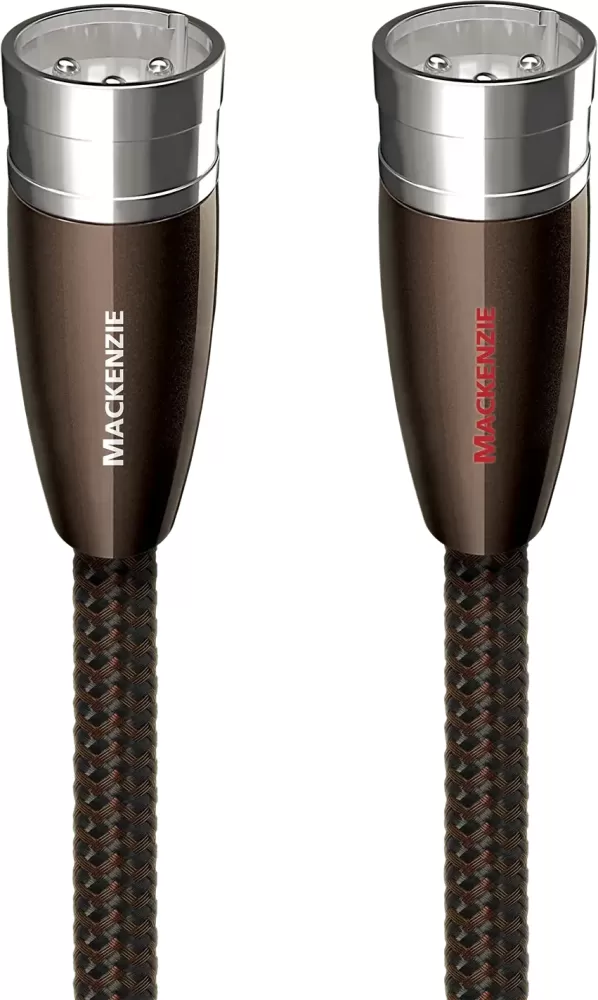AUDIOQUEST MacKenzie XLR Cables
The AudioQuest Mackenzie XLR analog-audio cable offers exceptional performance with solid Perfect-Surface Copper+ (PSC+) conductors, Foamed-Polyethylene insulation, and advanced Carbon Mesh-Network Noise-Dissipation, ensuring cleaner and clearer sound for a more natural listening experience.
The AudioQuest Mackenzie XLR cable is engineered to connect audio source components to amplifiers and receivers with precision and outstanding value. Featuring solid Perfect-Surface Copper+ (PSC+) conductors, this cable minimizes distortion, while Foamed-Polyethylene insulation preserves dynamic contrasts. Additionally, the advanced Carbon Mesh-Network Noise-Dissipation helps efficiently dissipate high-frequency noise, delivering cleaner, clearer, and more naturally beautiful sound reproduction.
Solid Perfect-Surface Copper+ (PSC+) Conductors
Solid conductors eliminate electrical and magnetic strand interactions, a common source of distortion. PSC+ Solid-Copper reduces distortion caused by grain boundaries and enhances linear RF Noise-Dissipation, resulting in cleaner, more accurate sound reproduction.
Carbon-Based 3-Layer Noise-Dissipation
Traditional shielding systems absorb and drain noise to ground, causing distortion. AudioQuest's Noise-Dissipation System (NDS) uses alternating metal and carbon-loaded synthetic layers to "shield the shield," absorbing and reflecting most of the captured Radio Frequency Interference (RFI) before it reaches the ground, ensuring a cleaner, more accurate signal.
Direction-Controlled Conductors
Metal strands have a directional grain structure that can affect performance. AudioQuest optimizes this by controlling RF impedance, ensuring noise is drained away from areas where it could distort the signal. Each batch of metal conductors is tested for sound quality, with arrows on the connectors indicating the optimal direction for signal and ground. This approach enhances Noise-Dissipation and ensures superior sound quality by properly dissipating induced noise.
Triple-Balanced Geometry
AudioQuest’s Triple-Balanced Geometry features a separate ground-reference conductor, ensuring that the cable’s shield isn’t used as a signal conductor. Whether configured with RCA or XLR plugs, the design employs three distinct conductors, allowing the positive and negative signals to follow equally superior, low-distortion paths. This geometry enhances overall performance and preserves the integrity of the audio signal.
Hard-Cell Foam Insulation
Hard-Cell Foam (HCF) Insulation helps maintain precise signal-pair geometry by minimizing distortion. Wire insulation and circuit board materials often absorb and release energy, introducing distortion. HCF insulation, similar to the Foamed-PE used in the Bridges & Falls cables, is nitrogen-injected to create air pockets. Since nitrogen, like air, doesn’t absorb or release energy, it reduces distortion. Additionally, the material's rigidity ensures that the conductors maintain a stable relationship along the entire length of the cable, further reducing distortion and stabilizing impedance.
Cold-Welded, Hanging-Silver Directly Over Pure Purple Copper Terminations
AudioQuest employs a cold-welding process that avoids the use of solder, which is a common source of distortion. Instead, the termination process uses a high-pressure technique to create a solid connection. The ground shells are stamped rather than machined, allowing for the use of metals selected for their low distortion properties, rather than for machinability. The result is a more pure, low-distortion connection that preserves the integrity of the audio signal.
|
|





Validate your login
Sign In
Create New Account